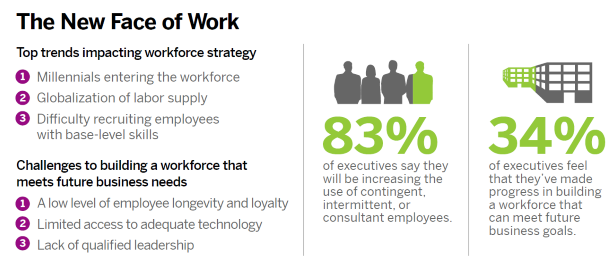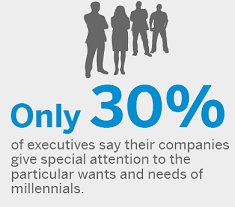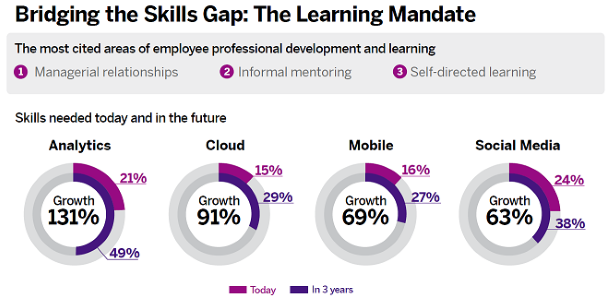Prepare for the 2020 Workforce
Preparing for the 2020 workforce is critical to business strategy, growth, and performance.
A recent SAP and Oxford Economics workforce report found that only 7% of Millennial workers received professional development through networking, as they rely more on formal training and mentoring for skill development. Also, 29% of Millennial workers globally expect more feedback than they get and 39% would consider leaving their jobs due to a lack of training and development.
The Looming Talent Crisis;
Workforce 2020 Overview
Preparing for the 2020 workforce is critical to business strategy, growth, and performance. To understand the challenges and opportunities, Oxford Economics and SAP surveyed over 2,700 executives and more than 2,700 employees in 27 countries during the second quarter of 2014.
We found that many companies lack the structure, strategy, culture, solutions and resources to manage employees effectively. To succeed, they must address the role and relevance of people strategy; changing demographics and evolving definitions of work; leadership ability and cultivation; employee wants and needs; and talent development.
The New Face of Work
Businesses must understand the workforce of the future and its importance to bottom-line success.

• The 2020 Workforce will be increasingly flexible.
83% of executives surveyed said they plan to increase use of contingent, intermittent, or consultant employees in the next 3 years forcing change on companies.
• The 2020 Workforce will be increasingly diverse.
HR management will need to become more evidence-based to deal with these realities.
• A lack of metrics and tools keeps HR from developing strategies for building the future workforce.
Most lack sufficient data on their strengths and vulnerabilities, and do not use quantifiable metrics and benchmarking in workforce development. Only 42% say they know how to extract meaningful insights from the data available to them.
• As a result, companies are not making progress toward meeting their workforce goals.
Nearly one-fifth of executives say they have made slight progress; 47% say they have made moderate progress; and just 33% say they have made good or significant progress.
•HR too often lacks the information or insights to be truly strategic.
HR often works with the C-suite but does not drive board-level strategy. Companies are executing on operational plans but lack strategic vision for the workforce.
The Millennial Misunderstanding
Millennials are different, but not as different as companies think!
• Several myths about Millennials are challenged by our research, including:
Millennials care more about making a positive difference in the world through work. Achieving work/life balance is more important to Millennials. Finding personal meaning in their work is more important to Millennials. Meeting income goals is less important to Millennials as long as they are learning and growing.
• But Millennials do need be managed differently, in terms of feedback and development.
Millennials rely more on formal training and mentoring to develop their skills. Millennials want informal feedback from their managers 50% more often than older peers.
What Matters Most at Work
Companies do not understand what their employees really want from them.
• When it comes to satisfied employees, compensation matters—a lot.
 The most important attraction and retention benefit for employees is compensation. Only 39% of executives say their company offers competitive compensation; other corporate offerings often fail to match up with employee preferences. Just 39% of survey respondents say they are satisfied with their job overall.
The most important attraction and retention benefit for employees is compensation. Only 39% of executives say their company offers competitive compensation; other corporate offerings often fail to match up with employee preferences. Just 39% of survey respondents say they are satisfied with their job overall.
• Executives value loyalty more than job performance.
Despite this preference, they are not focused on effective ways to engender loyalty. Employees have a distorted view of the qualities their bosses deem most important. The top three attributes executives want in employees are a high level of education and/or institutional training (33%), loyalty and long-term commitment 32%), and the ability to learn and be trained quickly (31%). The top three attributes employees think their leadership desire are the ability to learn and be trained quickly (34%), loyalty and long-term commitment (31%), and job performance and results (31%).
The Leadership Cliff
Executives and employees agree that leadership is lacking—and leadership development is lacking.
• Gaps in leadership capabilities spell trouble for future growth.
Executives cite a lack of adequate leadership as a major impediment to achieving workforce goals; only 35% say talent now in leadership positions is sufficient to drive global growth. About half of executives say their team has the skills to manage talent or to inspire and empower employees; leadership is not equipped to lead a global, diverse workforce.
• Employees agree with executives that leadership overall is lacklustre.
Just 44% of employees say that leadership at their company can lead the organization to success; even fewer say their company is committed to diversity. Ratings across a range of leadership attributes are middling at best. However, employees don’t cite direct manager quality as something that would improve their engagement, suggesting that upper-level quality should be improvement focus
• Most companies are not cultivating leadership within their organizations.
Planning for succession and continuity in key roles is not common. Few employees or executives say management values leadership ability in employees.
Bridging the Skills Gap: The Learning Mandate

Better training and education opportunities would benefit employees and businesses alike.
• For employees, obsolescence is a bigger concern than layoffs.
Employees say their top concern is their position changing or becoming obsolete. Millennials are dissatisfied with options for development and a clear career path.
• Technology skills development will continue to lag.
The need for technology skills will grow over the next three years, especially in analytics and programming/development. 48% say analytics skills will be needed by employees in three years, and 59% say programming/development skills will be needed. Ample training on essential technology is in short supply, as is access to the latest technology.
• Firms have difficulty finding skilled employees, but invest little in developing their own people.
Nearly half of executives say difficulty finding base-level skills affects their workforce strategy. An increase in the number of non-payroll positions may force new thinking on development.
• Firms struggle to develop a learning culture within their organization.
Roughly half of executives say their company is capable of retaining, updating, and sharing institutional knowledge and 47% say their company has a culture of continuous learning. Only 41% of employees say their company offers them opportunities to expand their skill sets.
To download the report in full click here»
Source: Success Factors - Workforce 2020 Insights